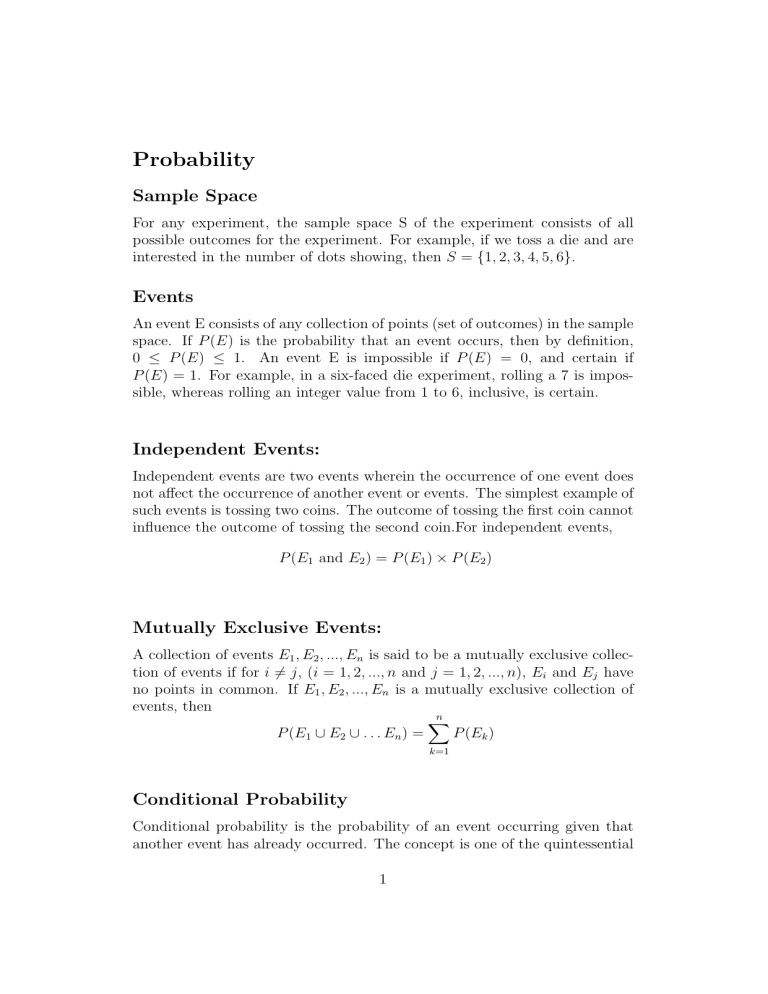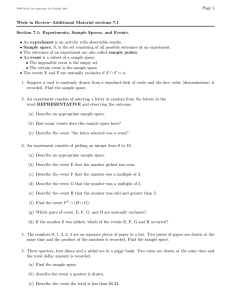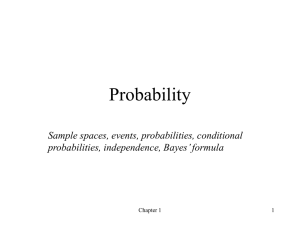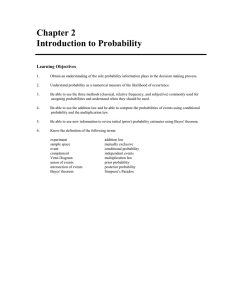Probability Theory: Sample Space, Events, Conditional Probability
advertisement

Probability
Sample Space
For any experiment, the sample space S of the experiment consists of all
possible outcomes for the experiment. For example, if we toss a die and are
interested in the number of dots showing, then S = {1, 2, 3, 4, 5, 6}.
Events
An event E consists of any collection of points (set of outcomes) in the sample
space. If P (E) is the probability that an event occurs, then by definition,
0 ≤ P (E) ≤ 1. An event E is impossible if P (E) = 0, and certain if
P (E) = 1. For example, in a six-faced die experiment, rolling a 7 is impossible, whereas rolling an integer value from 1 to 6, inclusive, is certain.
Independent Events:
Independent events are two events wherein the occurrence of one event does
not affect the occurrence of another event or events. The simplest example of
such events is tossing two coins. The outcome of tossing the first coin cannot
influence the outcome of tossing the second coin.For independent events,
P (E1 and E2 ) = P (E1 ) × P (E2 )
Mutually Exclusive Events:
A collection of events E1 , E2 , ..., En is said to be a mutually exclusive collection of events if for i 6= j, (i = 1, 2, ..., n and j = 1, 2, ..., n), Ei and Ej have
no points in common. If E1 , E2 , ..., En is a mutually exclusive collection of
events, then
n
X
P (E1 ∪ E2 ∪ . . . En ) =
P (Ek )
k=1
Conditional Probability
Conditional probability is the probability of an event occurring given that
another event has already occurred. The concept is one of the quintessential
1
concepts in probability theory. Note that conditional probability does not
state that there is always a causal relationship between the two events, as
well as it does not indicate that both events occur simultaneously.
P (E1 |E2 ) =
P (E1 ∩ E2 )
P (E2 )
(1)
Where:
• P (E1 |E2 ) the conditional probability; the probability of event E1 occurring given that event E2 has already occurred
• P (E1 ∩ E2 ) the joint probability of events E1 and E2 ; the probability
that both events E1 and E2 occur
• P (E2 ) the probability of event E2 .
The formula above is applied to the calculation of the conditional probability of events that are neither independent nor mutually exclusive. For
independent events, the conditional probability P (A|B) is given by
P (E1 |E2 ) =
P (E1 ∩ E2 )
P (E1 ) × P (E2 )
=
= P (E1 )
P (E2 )
P (E2 )
Another way of calculating conditional probability is by using the Bayes
theorem. The theorem can be used to determine the conditional probability
of event E1 , given that event E2 has occurred, by knowing the conditional
probability of event E2 , given the event E1 has occurred, as well as the
individual probabilities of events E1 and E2 . Mathematically, the Bayes
theorem can be denoted in the following way:
P (E1 |E2 ) =
P (E2 |E1 ) P (E1 )
, P (E2 ) > 0
P (E2 )
Example
Suppose we draw a single card from a deck of 52 cards.
1: What is the probability that a heart or spade is drawn?
2: What is the probability that the drawn card is not a 2?
2
3: Given that a red card has been drawn, what is the probability that it
is a diamond? Are the events
E1 = red card is drawn
E2 = diamond is drawn
independent events?
4: Show that the events
E1 = spade is drawn
E2 = 2 is drawn
are independent events
Solution
1: Define the events
E1 = heart is drawn
E2 = spade is drawn
E1 and E2 are mutually exclusive events with P (E1 ) = P (E2 ) =
We seek P (E1 ∪ E2 ).
P (E1 ∪ E2 ) = P (E1 ) + P (E2 ) =
2: Define event E = a 2 is drawn. Then P (E) =
Therefore
1
12
=
P (Ē) = 1 −
13
13
1 1
1
+ =
4 4
2
4
52
=
3:
P (E1 ∩ E2 )
P (E1 )
13
1
P (E1 ∩ E2 ) = P (E2 ) =
=
52
4
26
1
P (E1 ) =
=
52
2
P (E2 |E1 ) =
3
1
13
1
4
Thus
1
1
P (E2 |E1 ) = 4 =
1
2
2
1
Since P (E2 ) = 4 , we see that P (E2 |E1 ) 6= P (E2 ). Thus,E1 and E2 are
not independent events. (This is because knowing that a red card was
drawn increases the probability that a diamond was drawn.)
Baye’s Rule
An important decision often depends on the state of the world. For example,
we may want to know whether a person has tuberculosis. Then we would be
concerned with the probability of the following states of the world:
S1 = person has tuberculosis
S2 = person does not have tuberculosis
More generally, n mutually exclusive states of the world (S1 , S2 , ..., Sn ) may
occur. The states of the world are collectively exhaustive: S1 , S2 , ..., Sn include all possibilities. Suppose a decision maker assigns a probability P (Si )
to Si . P (Si ) is the prior probability of Si . Consider the diagram below;
To obtain more information about the state of the world, the decision maker
may observe the outcome of an experiment. Suppose that for each possible
outcome Oj and each possible state of the world Si , the decision maker knows
P (Oj |Si ), the likelihood of the outcome Oj given state of the world Si . Bayes
rule combines prior probabilities and likelihoods with the experimental outcomes to determine a post-experimental probability, or posterior probability,
for each state of the world. From (1),
P (Si |Oj ) =
P (Si ∩ Oj )
P (Oj )
(2)
and it also follows from (1) that
P (Si ∩ Oj ) = P (Oj |Si )P (Si )
4
(3)
The states of the world S1 , S2 , ..., Sn are collectively exhaustive, so the experimental outcome Oj (if it occurs) must occur with one of the Si . Since
S1 ∩ Oj , S2 ∩ Oj , ..., Sn ∩ Oj are mutually exclusive events, then it implies that
P (Oj ) = P (S1 ∩ Oj ) + P (S2 ∩ Oj ) + ... + P (Sn ∩ Oj )
(4)
The probabilities of the form P (Si ∩ Oj ) are often referred to as joint probabilities, and the probabilities P (Oj ) are called marginal probabilities.
Substituting (3) into (4), we obtain
P (Oj ) =
n
X
P (Oj |Sk )P (Sk )
(5)
k=1
Substituting (3) and (5) into (2) yields Bayes rule:
P (Si |Oj ) =
P (Oj |Si )P (Si )
P (Si ∩ Oj )
= Pn
P (Oj )
k=1 P (Oj |Sk )P (Sk )
(6)
Example II:
Suppose that 1% of all children have tuberculosis (TB). When a child who
has TB is given the Mantoux test, a positive test result occurs 95% of the
time. When a child who does not have TB is given the Mantoux test, a
positive test result occurs 1% of the time. Given that a child is tested and a
positive test result occurs, what is the probability that the child has TB?
Solution::
The states of the world are:
S1 = child has TB
S2 = child does not have TB
The possible experimental outcomes are;
O1 = positive test result
O2 = nonpositive test result
We are given the prior probabilities P (S1 ) = 0.01 and P (S2 ) = 0.99 and
the likelihoods P (O1 |S1 ) = 0.95, P (O1 |S2 ) = 0.01, P (O2 |S1 ) = 0.05, and
P (O2 |S2 ) = 0.99. We mant to determine P (S1 |O1 ) and
P (S1 |O1 ) =
P (O1 |S1 )P (S1 )
P (O1 |S1 )P (S1 ) + P (O1 |S2 )P (S2 )
5
=
(0.95)(0.01)
95
=
= 0.49
(0.95)(0.01) + (0.01)(0.99)
194
Tutorial Questions
1. Suppose two dice are tossed (for each die, it is equally likely that 1, 2,
3, 4, 5, or 6 dots will show).
(a) What is the probability that the total of the two dice will add up
to 7 or 11?
(b) What is the probability that the total of the two dice will add up
to a number other than 2 or 12?
(c) Are the events
E1 = first die shows a 3
E2 = total of the two dice is 6
independent events?
(d) Given that the total of the two dice is 5, what is the probability
that the first die showed 2 dots?
(e) Given that the first die shows 5, what is the probability that the
total of the two dice is even?
2. A desk contains three drawers. Drawer 1 contains two gold coins.
Drawer 2 contains one gold coin and one silver coin. Drawer 3 contains two silver coins. I randomly choose a drawer and then randomly
choose a coin. If a silver coin is chosen, what is the probability that I
chose drawer 3?
3. Cliff Colby wants to determine whether his South Japan oil field will
yield oil. He has hired geologist Digger Barnes to run tests on the
field. If there is oil in the field, there is a 95% chance that Diggers
tests will indicate oil. If the field contains no oil, there is a 5% chance
that Diggers tests will indicate oil. If Diggers tests indicate that there
is no oil in the field, what is the probability that the field contains
oil? Before Digger conducts the test, Cliff believes that there is a 10%
chance that the field will yield oil.
6
4. Of all 40-year-old women, 1% have breast cancer. If a woman has breast
cancer, a mammogram will give a positive indication for cancer 90% of
the time. If a woman does not have breast cancer, a mammogram will
give a positive indication for cancer 9% of the time. If a 40-year-old
womans mammogram gives a positive indication for cancer, what is the
probability that she has cancer?
5. Three out of every 1,000 low-risk 50-year-old males have colon cancer.
If a man has colon cancer, a test for hidden blood in the stool will
indicate hidden blood half the time. If he does not have colon cancer,
a test for hidden blood in the stool will indicate hidden blood 3% of
the time. If the hidden-blood test turns out positive for a low-risk 50year-old male, what is the chance that he has colon cancer?
7







